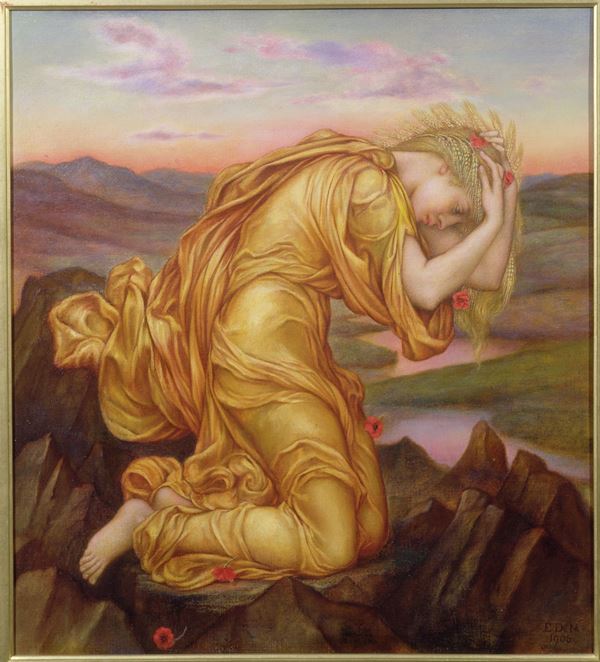NOSTALGIA EXHIBITION
STORIES AND EXPRESSIONS OF A FEELING
Palazzo Ducale, Genoa
March – July 2024
Curated by Matteo Fochessati, in collaboration with Anna Vyazemtseva
The Trustees of the De Morgan Foundation have recently lent Evelyn De Morgan’s painting ‘Demeter Mourning Persephone’ to a new exhibition on the theme of Nostalgia at the Doge’s Palace in Genoa.
In this exhibition, you are transported to a world where time isn’t just a linear concept but a tapestry woven with threads of longing, memory, and introspection. The majestic Palazzo Ducale is now host to a beautiful exhibition curated by Matteo Fochessati, in collaboration with Anna Vyazemtseva, which delves deep into the intricate layers of nostalgia, exploring its myriad forms and influences on art and culture.
Nostalgia, often regarded as a bittersweet reverie, finds its roots in history and literature. From Johannes Hofer’s pioneering exploration of homesickness to the poignant verses of poets like Dante Alighieri and Giacomo Leopardi, the exhibition traces the evolution of this complex emotion through the annals of time. The exhibition opens with “Demeter Mourning Persephone” (1909) by Evelyn De Morgan, on loan from the Trustees of the De Morgan Foundation. This haunting artwork encapsulates the essence of maternal grief and the eternal cycle of life and death. Demeter was the goddess of life on earth and Persephone, her much-loved daughter. When Persephone was sent to the underworld for six months of the year, Demeter would mourn, unable to give life to the world, and giving us autumn and winter. The painting is accompanied by other mythological figures such as Odysseus who was sent away from home on his years-long travels, and experienced longing for home on this epic journey.

The thematic journey through the exhibition unveils nine distinct chapters, each examining a specific aspect of nostalgia. From the yearning for a sense of belonging in “Nostalgia for the classical” to the timeless dream of paradise in “Nostalgia for Paradise,” the artworks on display serve as windows into the human soul, reflecting our deepest desires and aspirations.
The section on homesickness has some beautiful yet sorrowful paintings, such as Luigi Selvatico’s ‘Morning Departure’ (1899). In this realist and social-themed painting, Selvatico – evoking the feelings of sadness that often accompany the separation of departures – describes the melancholic atmosphere of the entrance hall of the old railway station in Venice, depicting in the foreground a young woman sitting on her luggage, pressing a handkerchief to her mouth to hold back tears. It is an unnerving scene to stumble upon.

As visitors navigate the labyrinthine corridors of the exhibition, they are confronted with the stark realities of “Structural Nostalgia,” where political ideologies intertwine with collective memory, shaping narratives of identity and belonging. Here, the ghosts of the past cast long shadows, reminding us of the dangers of historical revisionism and selective nostalgia.
Yet, amidst the shadows, there is light—the radiant glow of “Nostalgia for Infinity” and “Nostalgia for Happiness.” In the boundless expanse of nature and the fleeting moments of joy, we find solace and redemption. For nostalgia, in all its complexity, is ultimately a testament to the resilience of the human spirit, a beacon of hope in an ever-changing world. The scenes of funfair joy painted in the early twentieth century feel vaguely familiar. By setting the viewer just outside the glow of the lights from the car, the artist forces the viewer to be an onlooker, excluded from the fun as though recalling a happier time.

In the words of Marcel Proust, “Remembrance of things past is not necessarily the remembrance of things as they were, but as we would like them to be.” In celebrating our nostalgia, we celebrate our humanity—the eternal quest for meaning, connection, and belonging.
If you do find yourself in Genoa, be sure to visit De Morgan’s painting in this wonderful exhibition.






